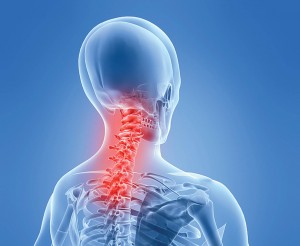By Jaye Sadler, Physical Therapist, Progressive Physical Therapy –


Most Common Causes of Neck Pain
Now that we know the incidence for neck problems, let’s examine the most common causes of neck pain.
Degenerative Disc Disease
As we age, the disc loses some of its water content and, as a result, some of its shock absorbing ability. The first changes that occur in the disc are tears in the outer ring of the disc, called the annulus. Tears in the annulus may occur without symptoms, therefore, you may not notice when they occur or what caused them. These tears heal by forming scar tissue. Scar tissue is weaker than normal tissue. Repeated injuries and tears cause more wear and tear to the disc. As the disc continues to wear, it begins to collapse. The space between each vertebra becomes smaller. Bone spurs may form around the disc and facet joints. It is thought that too much motion in a spinal segment causes the bone spurs to form. Eventually, bone spurs can form around the nerves of the spine, causing a condition called spinal stenosis.
Cervical Radiculopathy (Pinched Nerve)
Spinal Stenosis (Cervical Myelopathy)
Perhaps the most serious of the problems caused by degeneration of the spinal segment in the cervical spine is the condition of spinal stenosis. In the late stages of spinal degeneration, bone spurs from the degenerative process can cause spinal stenosis. As the bone spurs form, the size of the spinal canal becomes smaller. The bone spurs begin to press on the spinal cord or the nerve roots. Pressure on the nerves in the spinal cord can cause numbness, tingling, or pain in the arms, hands, and legs. This condition is sometimes called cervical myelopathy and is different from the simpler problem where only one nerve root is being pinched by a herniated disc or a bone spur.
When there is narrowing of the spinal canal (the bony tube where the spinal cord runs), the whole spinal cord may be affected. This is different than when the bone spurs only narrow one of the foramen (the openings where the nerve roots exit). The symptoms are much different. A pinched nerve from either a herniated disc or a bone spur rarely affects the legs. Cervical myelopathy can affect both the arms and the legs.
Common Symptoms for Neck Problems
The symptoms for neck problems can be different depending on the degree of degeneration and can be evaluated by diagnostic study per your doctors recommendations prior to starting physical therapy.
Some common symptoms are:
- Pain in your neck
- Headaches
- Pain in your shoulder, arm, or hand
- Reduced range of motion in your neck
- Numbness, weakness, and slower reflexes in your arms, hands,legs, or feet
- Problems walking, including a “spastic gait”
- Muscle weakness in your legs
Non-Surgical Treatment Options
Many patients experiencing these symptoms can benefit from non-surgical treatment options including: local injection, epidural injection, muscle relaxer/anti-inflammatory medications, and physical therapy.
Upon referral for physical therapy, you can expect to have a comprehensive evaluation which will allow the physical therapist to review your history and diagnostic testing and measure your range of motion and strength for areas of weakness, loss of flexibility or sensory changes. Special tests can further indicate the proper course of treatment to allow a safe return of your function and reduction of symptoms.
Typical Physical Therapy Treatments May Be:
- Heat or cold modalities
- Ultrasound and/or electrical stimulation
- Stretching/ROM exercise
- Strengthening exercise
- Postural education/ergonomic assessment
- Manual and/or mechanical traction
Our Health is the Most Important Thing We Have
The most important thing we have is our health and wellness. If you or a loved one are experiencing any of these neck problems, please feel free to stop by or call Progressive Physical Therapy to discuss how we may help you on your path to an active, healthy lifestyle. Call 941-743-8700 or visit us online at www.progressivehealthplex.com.
Jaye Sadler, Physical Therapist
Jaye was born in southern New Hampshire and has resided in the state of Florida since 1996. She has been a therapist for over 20 years and is married with two beautiful daughters.
Jaye graduated from the University of New England in Biddeford, Maine in 1989, and has been practicing in a variety of settings in New England and Florida since that time. Jaye has completed specialized training in manual therapy and has had experience working in pediatrics, neurology and orthopedic settings. Jaye has been with Progressive Physical Therapy since August of 2008 and enjoys the dynamic setting and challenging caseload.
When not working, Jaye and her family enjoy traveling, camping, and riding horses.
Progressive Health and Racquet Club
941-743-8700
www.progressivehealthplex.com
 Southwest Florida's Health and Wellness Magazine Health and Wellness Articles
Southwest Florida's Health and Wellness Magazine Health and Wellness Articles

